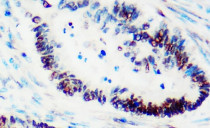ARG67005
anti-TLR3 antibody
anti-TLR3 antibody for ICC/IF,IHC-Formalin-fixed paraffin-embedded sections,Western blot and Human,Mouse
Immune System antibody; Microbiology and Infectious Disease antibody; Signaling Transduction antibody
Overview
| Product Description | Rabbit Polyclonal antibody recognizes TLR3 |
|---|---|
| Tested Reactivity | Hu, Ms |
| Predict Reactivity | Rat |
| Tested Application | ICC/IF, IHC-P, WB |
| Host | Rabbit |
| Clonality | Polyclonal |
| Isotype | IgG |
| Target Name | TLR3 |
| Antigen Species | Human |
| Immunogen | Synthetic peptide within the intracellular domain of Human TLR3. |
| Conjugation | Un-conjugated |
| Alternate Names | Toll-like receptor 3; CD antigen CD283; CD283; IIAE2 |
Application Instructions
| Application Suggestion |
|
||||||||
|---|---|---|---|---|---|---|---|---|---|
| Application Note | * The dilutions indicate recommended starting dilutions and the optimal dilutions or concentrations should be determined by the scientist. |
Properties
| Form | Liquid |
|---|---|
| Purification | Affinity purified. |
| Buffer | 100 mM Tris Glycine (pH 7.0), 0.025% ProClin 300 and 20% Glycerol. |
| Preservative | 0.025% ProClin 300 |
| Stabilizer | 20% Glycerol |
| Storage Instruction | For continuous use, store undiluted antibody at 2-8°C for up to a week. For long-term storage, aliquot and store at -20°C or below. Storage in frost free freezers is not recommended. Avoid repeated freeze/thaw cycles. Suggest spin the vial prior to opening. The antibody solution should be gently mixed before use. |
| Note | For laboratory research only, not for drug, diagnostic or other use. |
Bioinformation
| Database Links | |
|---|---|
| Gene Symbol | TLR3 |
| Gene Full Name | toll-like receptor 3 |
| Background | TLR3 Antibody: Toll-like receptors (TLRs) are evolutionarily conserved pattern-recognition molecules resembling the toll proteins that mediate antimicrobial responses in Drosophila. These proteins recognize different microbial products during infection and serve as an important link between the innate and adaptive immune responses. The TLRs act through adaptor molecules such as MyD88 and TIRAP to activate various kinases and transcription factors so the organism can respond to potential infection. TLR3 is known to recognize viral double-stranded (ds) RNA, a molecular pattern associated with viral infection. Recently it has been shown to recognize viruses such as Influenza A and West Nile Virus and can mediate entry of at least West Nile Virus.| |
| Highlight | Related products: TLR3 Antibody antibodies; Anti-Rabbit IgG secondary antibodies; Related poster download: Toll-like Receptor.pdf |
| Research Area | Immune System antibody; Microbiology and Infectious Disease antibody; Signaling Transduction antibody |
| Calculated MW | 104 kDa |
| PTM | Heavily N-glycosylated, except on that part of the surface of the ectodomain that is involved in ligand binding. TLR3 signaling requires a proteolytic cleavage mediated by cathepsins CTSB and CTSH, the cleavage occurs between amino acids 252 and 346. The cleaved form of TLR3 is the predominant form found in endosomes. |
Images (4) Click the Picture to Zoom In
-
ARG67005 anti-TLR3 antibody IHC-P image
Immunohistochemistry: Paraffin-embedded Human cancer tissue stained with ARG67005 anti-TLR3 antibody at 1:200 dilution.
-
ARG67005 anti-TLR3 antibody WB image
Western blot: Mouse lung tissue stained with ARG67005 anti-TLR3 antibody at 1:800 dilution, overnight at 4°C.
-
ARG67005 anti-TLR3 antibody ICC/IF image
Western blot: Jurkat cell stained with ARG67005 anti-TLR3 antibody at 1:400 dilution, overnight at 4°C.
-
ARG67005 anti-TLR3 antibody WB image
Western blot: K562 cells stained withARG67005 anti-TLR3 antibody at 1:800 dilution, overnight at 4°C.









